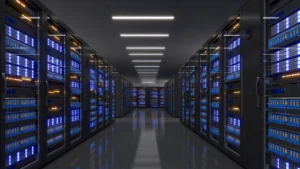As geopolitical tensions escalate and restrictions on semiconductor supplies intensify, Data Centers Must Stay Alert to maintain comprehensive oversight of their components.
The introduction of new tariffs and the complexities of the supply chain have made it increasingly challenging to procure dependable electronic components.
These difficulties are further exacerbated by heightened regulatory scrutiny, compelling data centers to implement more rigorous monitoring and compliance protocols.
The Significance of Oversight in Data Centers
Ensuring Adherence and Safety
According to Dell’Oro Group, with the surge in AI-driven advancements projected to result in nearly a 50% increase in capital expenditures for data centers in 2024, the importance of compliance has never been greater.
The anticipated investments in AI infrastructure by the incoming Trump administration underscore the necessity for data centers to adopt an innovation strategy that is centered on American interests.
Furthermore, it is expected that regulatory standards will tighten, thereby amplifying the need for sophisticated monitoring solutions.
The Function of PCBAs in Data Centers
Central to every data center are its servers, which rely on printed circuit board assemblies (PCBAs).
These assemblies are composed of a variety of electronic components, such as processors, resistors, and capacitors, sourced from around the globe.
However, while data center operators manage their installed systems, they frequently lack insight into the origins of these components, which presents considerable risks.
The intricate nature of supply chains makes it essential to verify the authenticity of each component, a task that is both challenging and critical.
A single defective capacitor, even one measuring just 1 square mm, has the potential to incapacitate an entire PCBA. This can result in substantial downtime, financial repercussions, and security risks.
Without thorough visibility into every component, data centers cannot ensure complete cyber-physical security for their operations.
Therefore, it is crucial to adopt advanced tools that offer real-time insights into the makeup and provenance of components.
Rising Restrictions and Their Impact on Data Centers
The Transition from Chinese Components
The United States is actively working to decrease its dependence on Chinese semiconductors and minerals.
During the second Trump administration, tariffs on Chinese semiconductors were raised to as much as 50%, prompting China to respond by prohibiting the export of vital materials such as gallium, antimony, and germanium.

Furthermore, the U.S. has placed 140 Chinese companies on its “Entity List,” which limits business interactions with these entities.
These measures have a significant effect on the availability of essential components, forcing data centers to explore alternative suppliers and invest in domestic production initiatives.
The Importance of Transparency
In light of these restrictions, technologies that ensure complete transparency regarding the origins of components have become crucial.
Such technologies enable data centers to comply with country-of-origin regulations, avoid the use of unauthorized components, and identify any instances of tampering.
Additionally, enhanced transparency builds trust among various stakeholders, including customers, regulators, and investors, who increasingly demand accountability within a complex global supply chain.
The Appropriate Instruments for Compliance and Security
Utilizing AI for Component Verification
In order to address regulatory challenges, data centers can employ visual AI and AI-enhanced data analytics.
These advanced technologies authenticate component legitimacy, monitor suppliers, and identify anomalies that may present security or compliance threats.
By automating the verification process, data centers can markedly decrease errors and improve operational efficiency.
Automated security measures mitigate the risks associated with counterfeit or substandard components, ensuring that all materials originate from approved sources.
Conventional approaches, such as depending on design specifications or reports from contract manufacturers, are susceptible to human error.
In contrast, AI-driven tools improve precision and reduce dependence on potentially inaccurate documentation. Additionally, real-time monitoring facilitates the prompt identification of non-compliant components, enabling rapid corrective measures.
Improving Traceability with Visual AI
Contemporary AI technologies capturing images of components from various perspectives, detecting defects or irregularities. By adopting these tools, manufacturers can achieve complete traceability down to the individual component level.
This detailed methodology guarantees that every hardware piece complies with rigorous regulatory and security standards.
Establishing real-time alerts for suspicious components, generating forensic reports for each printed circuit board assembly (PCBA), and maintaining comprehensive documentation should become standard practices to uphold compliance and security in data centers.
The implementation of these strategies not only protects data centers from potential cyber threats but also enhances operational efficiency by minimizing downtime and ensuring uninterrupted functionality.
The Evolution of Data Centers in Response to Regulatory Developments
The data center sector is experiencing a significant transformation due to geopolitical tensions and changes in regulations.

In the future, data centers will need to formulate comprehensive strategies to address supply chain vulnerabilities, diversify their sources of components, and invest in sophisticated tracking technologies.
Organizations that take proactive measures to navigate these challenges will be more likely to succeed in the changing landscape of digital infrastructure.
As data centers increasingly integrate artificial intelligence and automation, it is imperative that they also bolster their cybersecurity frameworks to safeguard against new threats.
AI-powered monitoring systems not only improve the traceability of components but also facilitate the real-time identification of vulnerabilities.
Enhancing cybersecurity measures will be a critical focus for data centers striving to maintain resilience in an unpredictable global context.
Expert Editorial Comment
Equipping data center operators with detailed insights into their components is vital for the industry’s future.
It is essential for data centers must stay alert and emphasize transparency to mitigate disruptions stemming from supply chain uncertainties and regulatory shifts.
By adopting AI-driven solutions, they can improve compliance, enhance operational efficiency, and strengthen security measures.
In light of changing trade policies, having a clear understanding of the internal workings of a data center is no longer a choice but a necessity.
By leveraging advanced technologies, data centers can secure stable supply chains, ensure regulatory compliance, and avert costly interruptions.
The future of data centers depends on their capacity to adapt to emerging challenges while preserving operational integrity and security.

